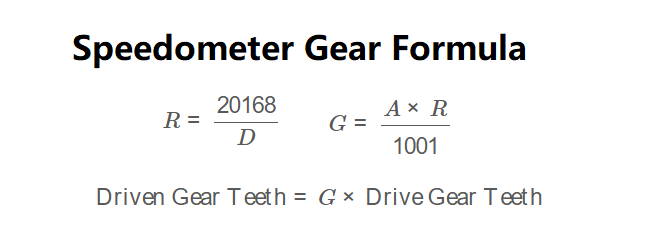1. What is a Speedometer Gear Calculator?
Definition: This calculator determines the number of teeth on the driven gear for a vehicle’s speedometer based on tire diameter, axle ratio, and the number of teeth on the drive gear.
Purpose: It ensures accurate speedometer readings after changing tire sizes, which affect the number of wheel revolutions per mile.
2. How Does the Calculator Work?
The calculator uses the following formulas:
Revolutions per Mile (R):
\[
R = \frac{20168}{D}
\]
Internal Gear Ratio Calculation:
\[
G = \frac{A \times R}{1001}
\]
Number of Teeth on Driven Gear:
\[
\text{Driven Gear Teeth} = G \times \text{Drive Gear Teeth}
\]
Where:
- \( R \): Revolutions per mile
- \( D \): Tire diameter (inches)
- \( A \): Axle ratio
- 20168: Approximately 63360/π (since 63360 inches = 1 mile)
- 1001: Calibration factor (speedometer calibrated to 1000 revolutions per mile, adjusted by 1001/1000)
- \( G \): Gear ratio (used internally)
Unit Conversions:
- Tire Diameter:
- 1 inch = 25.4 mm
- 1 inch = 2.54 cm
- 1 inch = 0.0254 m
- 1 inch = 0.0833333 ft
Steps:
- Enter the tire diameter, selecting the unit (mm, cm, m, inches, ft).
- Enter the axle ratio.
- Enter the number of teeth on the drive gear.
- Convert tire diameter to inches if needed.
- Calculate the revolutions per mile (\( R \)) using the first formula.
- Internally calculate the gear ratio using the axle ratio and revolutions per mile.
- Calculate the number of teeth on the driven gear by multiplying the gear ratio by the drive gear teeth.
3. Importance of Speedometer Gear Calculation
Calculating the speedometer gear teeth is crucial for:
- Accuracy: Ensuring the speedometer reflects the correct speed after changing tire sizes.
- Safety: Preventing speeding violations due to incorrect speed readings.
- Performance: Maintaining accurate odometer readings for vehicle maintenance.
4. Using the Calculator
Examples:
- Example 1: For \(\text{Tire Diameter} = 30 \, \text{inches}\), \(\text{Axle Ratio} = 3.73\), \(\text{Drive Gear Teeth} = 10\):
- Revolutions per Mile: \(\text{R} = \frac{20168}{30} = 672.27\)
- Driven Gear Teeth: \(\text{Teeth} = \left(\frac{3.73 \times 672.27}{1001}\right) \times 10 = 25\)
- Example 2: For \(\text{Tire Diameter} = 650 \, \text{mm}\), \(\text{Axle Ratio} = 4.10\), \(\text{Drive Gear Teeth} = 8\):
- Convert: \(\text{Tire Diameter (inches)} = 650 \div 25.4 = 25.59\)
- Revolutions per Mile: \(\text{R} = \frac{20168}{25.59} = 788.12\)
- Driven Gear Teeth: \(\text{Teeth} = \left(\frac{4.10 \times 788.12}{1001}\right) \times 8 = 26\)
5. Frequently Asked Questions (FAQ)
Q: Why does tire diameter affect the speedometer?
A: A larger tire diameter reduces the number of revolutions per mile, causing the speedometer to underreport speed unless the gear teeth are adjusted.
Q: What is the axle ratio?
A: The axle ratio is the ratio of the number of rotations of the driveshaft to the number of rotations of the axle, affecting the vehicle’s gearing.
Q: How accurate is the calculation?
A: The calculation is accurate for the given inputs but assumes a standard speedometer calibration (1000 revolutions per mile). Actual gear ratios may vary slightly due to manufacturing tolerances.
Speedometer Gear Calculator© - All Rights Reserved 2025
 Home
Home
 Back
Back
